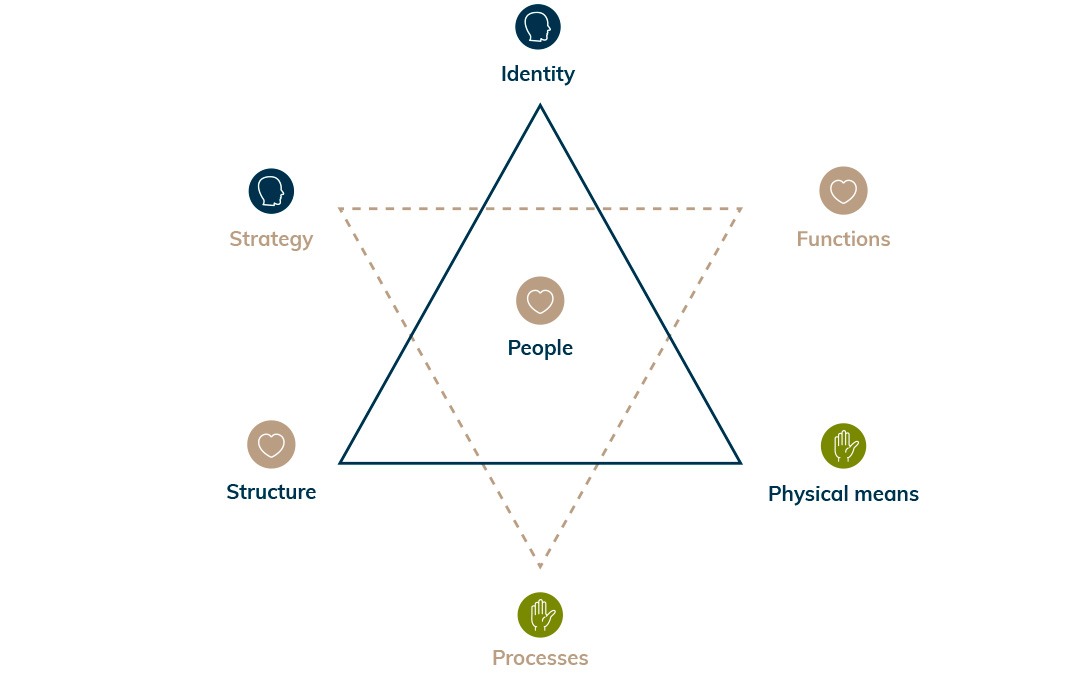Digital transformation is a fundamental change that can only be fully understood with a holistic model approach. The seven essential elements of an organization and their interrelationships can be well understood using the example of the digital transformation of a purchasing department.
Companies with a high potential for the future have a special mindset that promotes innovation. Innovative companies are characterized by a culture of innovation that supports pattern breaking and gives the »fools« in the company room to contribute. Interrupting patterns promotes innovation. Agile working also requires a completely new approach. Compared to the traditional procedure, the iterative approach of the agile method SCRUM with »retros« and »reviews«, for instance, is a clear pattern interruption. In addition, self-organization – whether in agile work or without this specific iterative element – requires a new relationship culture, i.e. new patterns in the relationship design. Last but not least, pattern interruptions also play a major role in the mega topic »digital transformation«; more on this topic in this blog post. When it comes to innovation, one often thinks of inventing »something«. However, digital transformation is a good reminder that you sometimes have to »reinvent yourself« in order to keep up and fit in with the modern times.
Transformation means more than just change
The classic »change process« usually describes a linear transition from an initial state to a target state. With a real »transformation«, on the other hand, one does not really know from the start in which target state one will end up. A transformation is highly complex and influenced by numerous unpredictable parameters – mind the »VUCA conditions«.
It is useful to have a model for this comprehensive consideration of the transformation. We use the »system concept« according to Trigon (Professor Glasl) for this purpose. It contains the seven essential elements of an organization. It makes sense to observe all seven essential elements and to analyze whether and to what extent they change during the transformation.
The seven essential elements of an organization
Here is a first overview of the character of the seven essential elements of an organization:

1. Identity (including concepts such as vision, mission, and purpose of the organization): What is our fundamental self-image as an organization? What is our contribution to society or (somewhat more profane) the economic system in which we operate?
2. Strategy (also corporate policy): what is our business model? Which principles or basic rules should guide us in our economic activity?
These two essential elements can be described as the »head« of the organization (or »cultural subsystem« in Glasl’s taxonomy).
3. Structures: These include the organizational structure (the organizational chart), the layout of the organization, and the design of the management hierarchy.
4. Functions: How are the tasks divided into individual functions and organs?
5. People: How can the climate in the company be characterized? How can the management style be described? What is the mindset (basic or specific attitudes) of the employees? How are ambivalences (e.g. conflicts and diversity) dealt with?
These three essential elements can be described as the »heart« of the organization (»social subsystem« in Glasl’s taxonomy).
6. Processes: How are the work processes in the company designed? How (transparently) is information provided? Who is involved and when? How are meetings organized?
7. Physical means: How modern is the infrastructure in the company? How is the company equipped with hardware and software? How many locations exist and how are they distributed regionally? How are the workplaces designed (open-plan vs. individual offices vs. home office)?
These two essential elements can be described as the »hand« of the organization (»technical-instrumental subsystem«).
Identity, structure and physical means can be described as the stabilizing (and in the long run rather constant) aspects of the system, while strategy, functions and processes, on the other hand, have a rather short-term and dynamic effect on the system of the organization. It becomes clear that the various elements are interdependent: If one element is changed, other elements of the system change as well. It is therefore a matter of conscious analysis and change of the entire system of the organization. An isolated change of a single essential element is not possible. In business practice, unfortunately, there is often the pretense that one can change a single element separately without touching or considering the others.
The practical benefit of the system concept
A model like this is not meant to provide simple answers. Rather, it helps decision-makers to ask smart questions. The right questions are often much more relevant to the success of a company than the quick answers. Therefore, the question: “What is the best constellation of the seven essential elements?” is pointless without considering a concrete context.
It becomes clear that there cannot be one »objective« answer to this question – but only a highly individual, temporary answer specific to the company. Therefore, a more useful question could be: “Which constellation is appropriate and useful for us in the current situation – given our history and the resources we derive from it and with a clear orientation towards our desired future?”
The digital transformation of a purchasing department analyzed with the model of the seven essential elements
The model of the seven essential elements can best be understood by means of an example: Let’s imagine a purchasing department of a large industrial company that is going through a digital transformation. The cost and efficiency pressure on purchasing departments is increasing. At the same time, the possibilities are growing as a result of the digital transformation. Big data, artificial intelligence and platform economy are just a few of the buzzwords that come to mind in this context. But even today these buzzwords have already a very concrete influence on the work context and the work organization of the people.
How the platform economy is transforming purchasing
But what are the effects of a platform economy when consistently thought through? Pricing is becoming increasingly transparent. Value chains are becoming increasingly integrated – and are developing into value networks. The cost structure of suppliers, but also that of producers, is becoming more and more public. The »poker face« in purchasing negotiations is becoming superfluous, as everyone is laying their hands openly on the table anyway. The rules of the game change fundamentally. Perhaps one realizes that one must invent a new game, in order to be able to remain further in the game. And this point is extremely important to keep in mind: It’s not just a matter of digitalizing the existing processes. Rather, it is a question of making full use of the possibilities offered by digitization. And this often goes hand in hand with an adaptation of business models.
So it is by no means just the »processes« that have to be adapted – even if these are the most obvious changes. Rather, the changes in processes often entail changes in hardware and software (»physical means«): data is automatically aggregated, analyzed and displayed so that employees can quickly gain an overview. This changes the decision paths and also the way in which the people in the department coordinate and work together.
But these are only the more obvious changes. The changed way of working can lead to changes in the layout of the purchasing department (e.g. dismantling silos – or vice versa setting up specialized sub-departments). In addition to the »functions«, changes in the »structure« (organization chart) can also be affected. It is even possible that the »strategy« of the purchasing department has to be adapted, since value creation now takes place in a different way – no longer through »hard negotiations«.
A transformation affects the self-image of employees
The most fundamental change, however, concerns the people themselves – their »self-image«, i.e. their professional »identity« as purchasers. The self-conception as a purchaser is changing due to the digital transformation. Where the purchaser used to be known for achieving good results by keeping a poker face even in tough negotiations, in the future the platform economies will negotiate the best price transparently and automatically. The human being as a negotiator in the narrower sense is no longer needed. The buyer must redefine his role and his function in this system. In the future the purchasing agent will be needed above all as a problem solver and »relationship manager«. People will be needed in particular when problems arise with suppliers or their products. This requires completely new competencies from the procurement staff; other values become relevant for the work. In short: the self-image of the purchaser changes fundamentally. For the individual employee, this means having to reinvent themselves completely. Old skills and patent remedies no longer work. Previous values must change. However, this can only succeed for the individual if these values are also lived out in the company itself. It makes sense that the digital transformation outlined here also has an impact on the culture (and the »people« in the taxonomy of the system concept) of the company.
The basic neurobiological needs must be protected in the transformation
In a transformation, the leaders are challenged not only to be role models for the transformation. Leadership must also protect and satisfy people’s basic neurobiological needs. The human need for security and certainty is put to the test in a transformational process. The management can counteract the insecurity of the team by emphasizing and promoting »connectedness«. Especially when the perceived status or »self-esteem« of employees – e.g. through changed roles – is in jeopardy, leadership needs sensitivity to safeguard these needs. Especially in times of transformation, it is important to actively involve employees (need for »self-efficacy«).
